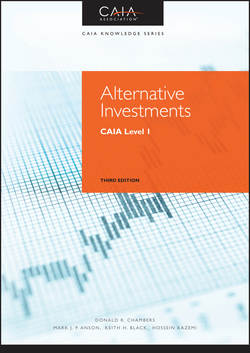Читать книгу Alternative Investments - Hossein Kazemi - Страница 13
На сайте Литреса книга снята с продажи.
PART One
Introduction to Alternative Investments
CHAPTER 1
What Is an Alternative Investment?
1.2 Alternative Investments by Inclusion
1.2.3 Private Equity
ОглавлениеThe term private equity is used in the CAIA curriculum to include both equity and debt positions that, among other things, are not publicly traded. In most cases, the debt positions contain so much risk from cash flow uncertainty that their short-term return behavior is similar to that of equity positions. In other words, the value of the debt positions in a highly leveraged company, discussed within the category of private equity, behaves much like that of the equity positions in the same firm, especially in the short run. Private equity investments emerge primarily from funding new ventures, known as venture capital; from the equity of leveraged buyouts of existing businesses; from mezzanine financing of leveraged buyouts or other ventures; and from distressed debt resulting from the decline in the health of previously healthy firms.
Venture capital refers to support via equity financing to start-up companies that do not have a sufficient size, track record, or desire to attract capital from traditional sources, such as public capital markets or lending institutions. Venture capitalists fund these high-risk, illiquid, and unproven ideas by purchasing senior equity stakes while the start-up companies are still privately held. The ultimate goal is to generate large profits primarily through the business success of the companies and their development into enterprises capable of attracting public investment capital (typically through an initial public offering, or IPO) or via their sale to other companies. In the context of investment management, venture capital is sometimes treated as a separate asset class from other types of private equity.
Leveraged buyouts (LBOs) refer to those transactions in which the equity of a publicly traded company is purchased using a small amount of investor capital and a large amount of borrowed funds in order to take the firm private. The borrowed funds are secured by the assets or cash flows of the target company. The goals can include exploiting tax advantages of debt financing, improving the operating efficiency and the profitability of the company, and ultimately taking the company public again (i.e., making an IPO of its new equity). Management buyouts and management buy-ins are types of LBOs with specific managerial changes.
Mezzanine debt derives its name from its position in the capital structure of a firm: between the ceiling of senior secured debt and the floor of equity. Mezzanine debt refers to a spectrum of risky claims, including preferred stock, convertible debt, and debt that includes equity kickers (i.e., options that allow investors to benefit from any upside success in the underlying business, also called hybrid securities).
Distressed debt refers to the debt of companies that have filed or are likely to file in the near future for bankruptcy protection. Even though these securities are fixed-income securities, distressed debt is included in our discussion of private equity because the future cash flows of the securities are highly risky and highly dependent on the financial success of the distressed companies, and thus share many similarities with common stock. Private equity firms investing in distressed debt tend to take longer-term ownership positions in the companies after converting all or some portion of their debt position to equity. Some hedge funds also invest in distressed debt, but they tend to do so with a shorter-term trading orientation.
